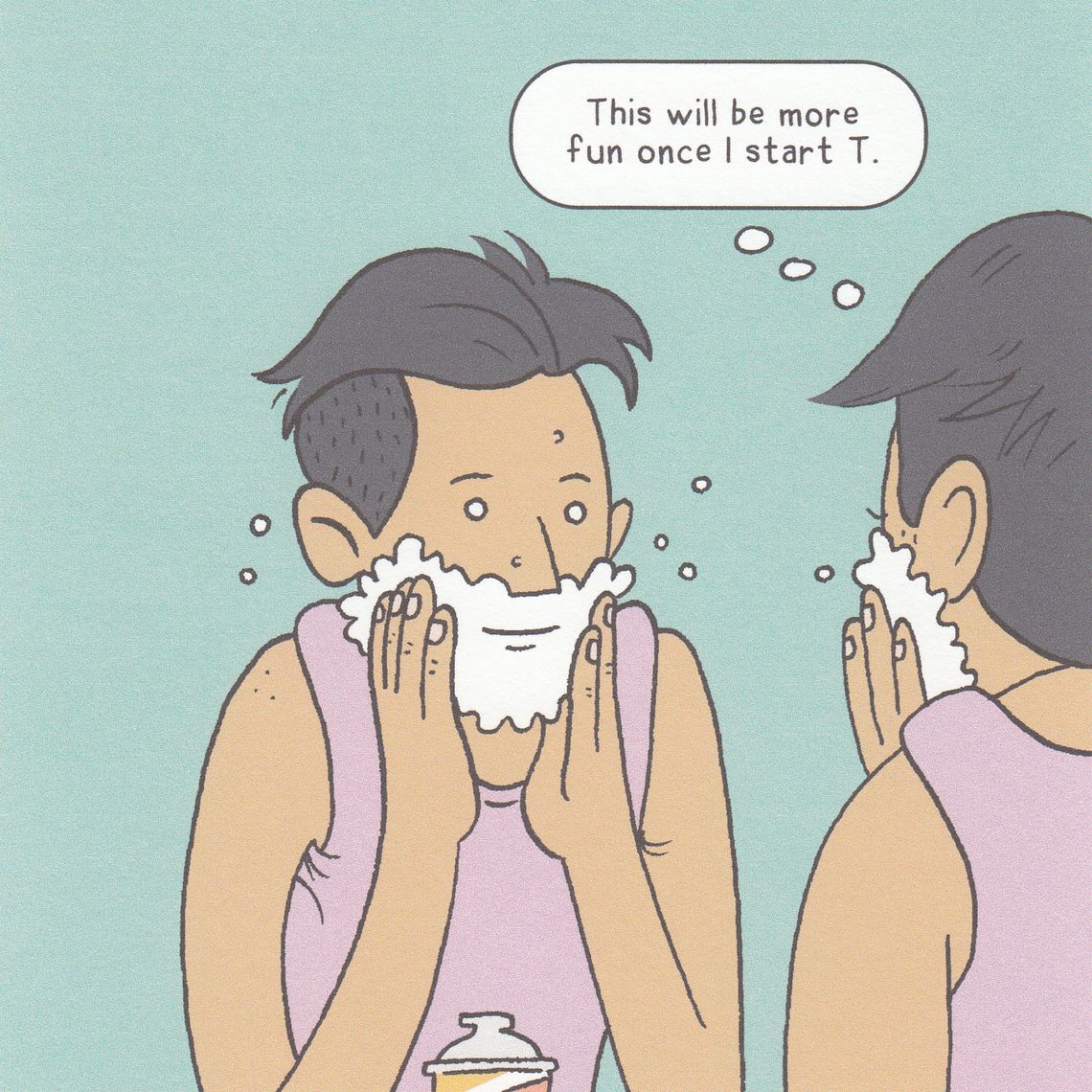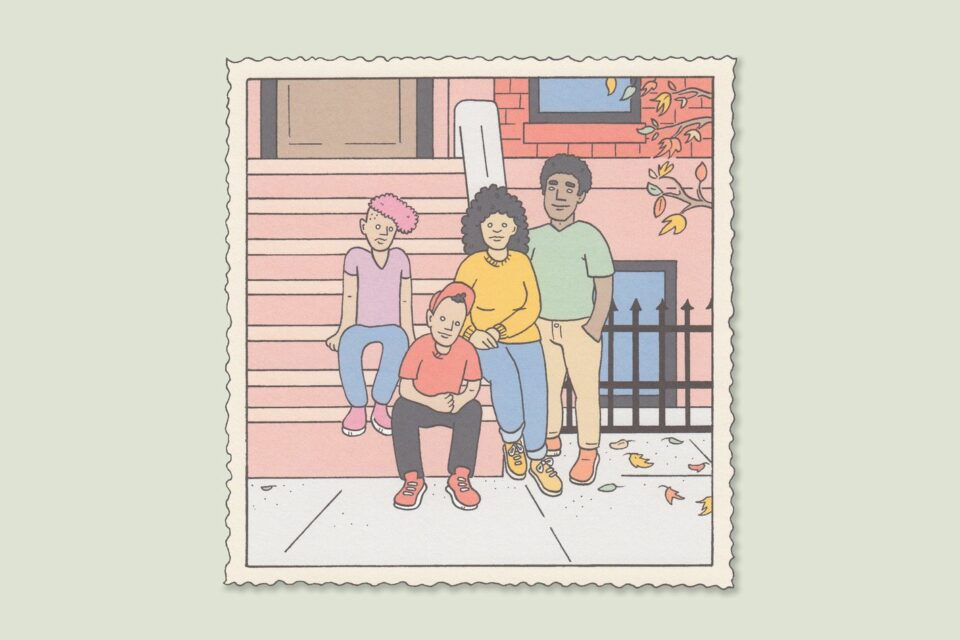Illustration: Erin Nations
This article, originally published June 22, 2023, was a National Magazine Award finalist for excellence in service journalism. The reporting has been updated so that it continues to be a resource for transgender kids and their families. It was featured in One Great Story, New York’s reading recommendation newsletter. Sign up here to get it nightly.
You’re walking to the bus stop, and your child tells you they want to wear a dress to school. Or they want a buzz cut. Or to paint their nails. Or maybe they tell you they’re transgender, or gender-queer, or trying to figure out if they’re a girl, a boy, or somewhere in between. There is plenty of rhetoric out there that might encourage a parent to question their child in this moment that’s designed to scare them into inaction or, worse, outright rejection. There is less guidance for those who choose to believe their children. This is a handbook for the trans-affirming family; it presumes you love your child and want what’s best for them. And while it’s their journey alone, you have the opportunity, and obligation, to help them to become who they are.
So what does that look like? Supporting your child’s transition might feel confusing, insurmountable even, full of high-stakes decisions and opaque systems to navigate. We’ll start with the good news: In more than 100 conversations with transgender children and adults, their parents, and health-care providers, we found that many big-picture questions have pretty straightforward answers. That includes the hard stuff, too, like how they weighed medical decisions and dealt with bullying. Then came the practical tips: dozens of pieces of advice on what to read, where to shop, and how to find ways to connect as a family. Parents shared the texts they sent to classmates’ parents, the talking points they used with well-intentioned but misinformed family members, and the ways they found welcoming spaces for their children. Some of them had never met a transgender person prior to their child’s coming out; others are transgender and nonbinary parents themselves.
Many families we spoke with face lawmakers eager to punish them for providing their child with gender-affirming care. This guide takes those realities seriously. And while we made this for parents, because they’re the ones talking to the principal, signing up for camp, and arranging doctors’ appointments, we hope this guide can be read together as a family. Every transition is different, so not every piece of advice will apply to your family, nor will it substitute for the important roles of your doctors, lawyers, and mental-health professionals. These are personal stories, not rules. We invite you to cherry-pick from this trove of information. Think of this as a friendly group chat with dozens of members.
How to support your child’s transition
➼ So Your Child Just Came Out As Trans Or Nonbinary
➼ Telling People (When Your Child Is Ready)
➼ A Shopping Guide
➼ Dealing With the School
➼ Puberty Blockers and Hormones Don’t Have to Be Scary
➼ When to Move (And When to Stay Put)
So Your Child Just Came Out As Trans Or Nonbinary

Illustration: Erin Nations
When She Says She’s a Girl, Trust Her
By Theresa Thorn
It was the week before Thanksgiving in 2016 when my kindergartner said, “I think I’m a girl with a penis.” We were in the restroom at a wedding reception for a friend of mine. “Okay,” I said, a thousand thoughts flooding my brain. “Okay,” I said again in the calmest voice I could muster. “Thank you for telling me. I love you so much.” Then, as we washed our hands and went back to the party, “We’ll figure it out, okay?”
In hindsight, my firstborn, who had been assigned male at birth, had been trying to signal to me about her gender for a while and, without understanding the harm I was doing, I had been subtly dismissing her hints and gestures. I knew trans kids existed, but I hadn’t thought my kid was trans, which led me to discourage her from wearing a dress on Picture Day (“It’ll be confusing”) and repeatedly cut her hair (“It’s just easier this way”). To me at the time, these had been simple exercises of parental judgment. To my child, they had probably been rejections. By spelling it out in no uncertain terms on the night of the reception, she told me she needed me to start really seeing her. And I honestly wanted to. I wanted to understand every corner of this mysterious little person I helped bring into the world. But to see her for real meant I needed to trust her in a way I never really had before.
But What If She Changes Her Mind When She’s Older?
Almost every parent we spoke with wondered, Is this a phase? After all, young people try on and discard so many styles and ideas and interests on their way to becoming themselves. When Christina and Erik’s 11-year-old, Alex, told them she was a girl two years ago, the question of whether “this is forever” seemed, for a moment, critical. (The family asked us not to use their real names.) But then Christina remembered something she’d learned in a workshop: “Identity is fluid, and gender is fluid. That doesn’t determine its reality. And it isn’t your business how long it’s going to last.” So she and Erik decided that “instead of trying to predict, we’ll respect the phase. We wouldn’t say, ‘No, you don’t like trucks now because you’re not going to like trucks next year.’ That’s not how you raise kids.”
Visit This Site That Everyone Told Us Was the Best Place to Start For Trans Kids And Their Parents
Gender Spectrum, founded by Stephanie Brill, is beyond comprehensive, offering everything from training sessions for coaches, pastors, and lawyers to tip sheets on how to handle dress-code discrimination to Zoom sessions for the parents of color. Many parents told us that its guide to communicating with schools, including scripts for meetings with administrators and teachers, was the best one out there.
Try to Meet Other Parents Of Trans Kids
Although PFLAG is 50 years old, it’s still the first stop for many parents, with nearly 400 chapters across the country. Early in Dev Green’s transition, a therapist referred them and their family to a local branch. “It was a really amazing place for my parents to process hard emotions,” Dev says. “I think PFLAG was the big step that got my parents onboard.”
Facebook groups and pages are huge too. Parents of Transgender Children may be the largest. For Raydra Hall, the parent of a trans son, Moms of Trans Boys was the most important. “It was comforting to know other people all over the world are in the same position, trying to do what’s best for our kids.” Mary Siever, the mother of three trans and nonbinary children, joined Mama Dragons, where she appreciated the space for people to be “upset or whatever in a safe place without putting that on their child,” and FreedHearts, for queer-affirming religious people.
Find Ways to Introduce Them to Trans Adults
Seven years ago, Joanna Cifredo was working at the National Center for Transgender Equality when then-5-year-old Ellie Ford came into the office. Cifredo became like an “auntie” to Ellie. She is amazed at the ways Ellie’s upbringing is “profoundly different from what seemed possible when I was a kid,” and she loves “helping — and bearing witness to — Ellie grow into their own.” Ellie says, “Aunt Joanna is like my trans protector, and we can relate. I feel safe when I’m with her.” Tony Ferraiolo facilitates an art group for trans youth and stays close to many of them. He says, “I’m able to say to them what I needed to hear when I was their age and there was nobody there to say it.”
➼ Read Janet Mock, Emira D’Spain, and 13 others on what helped them through their transition
Here’s a Place to Find A Trans Mentor
The Sam & Devorah Foundation for Trans Youth’s Trans Mentor Project connects young people with older ones around the country, depending on the type of mentor they’re looking for (say, a fellow Black transfemme). The nonprofit’s executive director, Wren Rhodes — who is based in Florida, where there has been a flurry of anti-trans legislation — suggests asking about how a group addresses data privacy before joining: “Instead of Zoom, we use a more secure platform called MentorCity. We don’t actually take any personally identifying information like addresses.”
There’s a Whole World of Super-Specific And Helpful Sub-Reddits & Vlogs
Sub-Reddits
• r/asktransgender forencyclopedic answers to any and all questions.
• r/transfashionadvice for outfit ideas.
• r/transpositive for uplifting content.
• r/transvoice for voice training.
• r/nonbinarytalk, r/ftm, r/mtf, and r/blacktransmen for identity-based groups.
Vlogs
• Jammidodger’s YouTube videos were recommend by multiple young people. “Even though he’s a trans guy instead of a trans woman, he helped me figure out, Hey, that’s kind of like what I want to do,” says Hazel, 18. The vlogger (real name: Jamie Raines) is a favorite of Dev’s as well: “He helped me to see a future for myself at a time when I thought I wouldn’t have support from my parents.”
• UppercaseCHASE1 is anotherfavorite of Dev’s. “Chase temporarily stopped using testosterone, so when I was considering doing that, I watched the videos about what changes are reversible and what changes are not.”
• Maya Henry and Samantha Lux kept 25-year-old Alexis Myers company when she was first transitioning: “They both documented their transition early on, so I got to follow along as I was going through my own.”
And A Number of Camps Exist for Trans Kids
In upstate New York: Unirondack
In Massachusetts: The Rowe Center
In New Hampshire: Harbor Camps
In Missouri: Camp Indigo Point
In Ohio: Camp Lilac
In Southern California: Camp Mulberry
In Southern Ontario: Niizh Manidook Hide Camp
Let Your Trans Kid Know You’re ‘Doing the Work’
Some time after I told her I was trans in high school, my mom got in her car and drove to the library. I wasn’t there, but I can imagine her going up to the big, gray desktop computer and tapping in unfamiliar search terms like transsexual and transgender. She was the kind of person who liked to hold a book in her hands, to feel the weight of the information it could impart. When I saw the stack of laminated covers on her nightstand, I wept with gratitude. She was engaging in an independent study to better understand me. From there, her questions changed too. Suddenly, she was prefacing things with “Some transgender people have said.” I lost my mom nine years ago, and I still think about that stack of books on her nightstand every day. —Liam Lowery, trans man
Read These Books That Celebrate Trans and Nonbinary Kids
With Your Little One …
Tony Ferraiolo’s two favorite books for the very young are Red: A Crayon’s Story, by Michael Hall (“Red is a blue crayon that’s labeled red”), and Neither, by Airlie Anderson, about a character who is “not quite a bird and not quite a bunny.”
Julián Is a Mermaid, the winner of a Stonewall Book Award from the American Library Association, is a beautifully illustrated story of self-discovery at the Coney Island Mermaid Parade.
It Feels Good to Be Yourself, by Theresa Thorn, is another lovely picture book.
The Gender Identity Workbook for Kids is “such a gentle, sweet book,” says Betsy Colton, the parent of an 8-year-old trans daughter. “Anything with Diane Ehrensaft’s name on it will be good.”
“I’ve been trying to find more books where queer identity is not the plot but just part of the story,” the mother of an 8-year-old trans girl told us. She recommends When Aidan Became a Brother, by Kyle Lukoff.
… Or Your Young Adult …
Zenobia July, by Lisa Bunker, is a coming-of-age story and mystery featuring a middle-school-age trans protagonist.
Molly Knox Ostertag’s The Witch Boy trilogy is “a trans allegory,” says Mickie, the parent of two nonbinary children. It follows a family “where the girls do magic and the boys shape-shift” with a protagonist who is “a boy who wants to do magic.”
Two families recommend Cory Silverberg’s gender-inclusive puberty and sex-ed books. You Know, Sex: Bodies, Gender, Puberty, and Other Things is oriented toward teens and tweens.
YouTuber and therapist Chloë Goldbach likes The Queer and Transgender Resilience Workbook, by Anneliese Singh. It’s educational but written “in a very accessible way — it’s not super-jargony” and includes exercises for “identifying harmful messages that we’ve internalized” and challenging them by finding more affirming ways to think about our bodies.
… Or On Your Own
Several families recommend The Transgender Teen, by Stephanie Brill and Lisa Kenney, and Beyond Pronouns, by Tammy Plunkett. “If I had Beyond Pronouns before my children came out to me, it would have been such a help,” Mary Siever says.
You May Want to Get a Couples Counselor
Whether a child’s coming out is joyful or fraught or low-key, parents are on a path for which they’ve probably had few models for how to proceed. Nearly all the parents we spoke with spent some time in therapy. When Tammy Plunkett’s child Mitchell came out as trans six years ago, she and her husband started couples therapy because “we both processed at very different rates,” says the Beyond Pronouns author. She was faster and therefore carried “a lot of the emotional labor” and also managed Mitchell’s medical logistics. When another child, Rose, came out last summer, the couple went back to counseling to figure out how to better work together. Ask members of your parent group to recommend counselors they worked with themselves or to tell you whom to stay away from.
Help Your Trans Kid Choose a New Name
Kids may mine favorite books or movies or ask about names that were on your shortlist before they were born. Sometimes names just fall into place. On a car ride, Ellie Ford’s parents brainstormed with them. Ellie was holding an elephant blanket they loved. Their mother pitched: “How about a name like Ellie?” When they arrived, Ellie “jumped out of the car, ran up to a little kid, and said, ‘Hi, I’m Ellie, nice to meet you.’ Ellie had never run up to anybody and talked to them before.” Family nicknames might change too: Cameron Pierce’s mother had called him her “Super Bunny Girl” since he was a baby. When he came out, “she started calling me ‘Super Bunny Boy,’ which cracked my heart in two,” he says. The nickname is “something she’s been saying unconsciously for 20 years. For her to call me her son and then modify my childhood nickname so easily — that was the most meaningful thing.”
Consider a Document Update for your Trans Kid
Alex and her parents used to worry about traveling, especially going through airport security. Then they legally changed Alex’s passport to reflect her accurate gender identity. “It felt like after years of not seeing myself in a mirror, I saw who I truly was,” Alex says. “When that passport came and the picture of her matched the gender listed, it felt like the whole world had just opened up,” her mother says. “It allows a freedom and a safety that felt out of reach for us.” Gender markers on passports are easier to update than on other documents; find details at the National Center for Trans Equality’s Document Center.
The process to change your name on a birth certificate or drivers license legally varies by state, but in each state there are lawyers who can help, often for free or low cost. To find a lawyer to help secure a name change, start with your local LGBTQ community hubs to ask for recommendations. You can also reach out to national trans focused groups like TLDEF, or to local free legal services providers, like Legal Services NYC in New York or Equitas Health in Ohio, for more information on getting a legal name change.
Have a Name-Change Ceremony:
The court hearing that made Quinn’s name change official happened during COVID, but the 16-year old’s family still marked the occasion: “I wore a nice blazer and a polo shirt. I took photos outside our house afterward with my little trans flag.”
Offer to Take Down Old Photos
“I came home one day and all the photos of my son prior to social transition were either face down or turned around. He told me, ‘Mom, I just feel like if somebody comes and visits and sees these photos, they’re going to think something’s wrong with me.’ So we held hands and we pulled all the photos down. And he told me that I could hold on to them. And then he’s like, ‘Thank you, Mom,’ and happily skipped off.” —Lizette Trujillo, mother of a 15-year-old trans boy
A Gift Can Go a Long Way:
“The first birthday after I told my dad I was starting testosterone, he gave me a pair of aggressively masculine Ethos dumbbells, which was something I wanted but had never mentioned to him and thus a very memorable gift.” — Erin Schwartz, transmasc nonbinary
And Honestly So Can a Text Message

Xavier Schipani
It’s Okay If You Weren’t the First to Know About Your Child’s Transition
It may be tempting to feel bad if your child comes out to their friends or teacher or favorite uncle before you, but it makes sense that they would share big news with a lower-stakes audience first. Tread lightly if you hear about it from a third party. Zaid, a nonbinary 17-year-old, was outed to their mother last year. “She was supportive but confused,” Zaid says, and they felt frustrated that their mother didn’t simply ask how she could support her child. When Siever’s eldest was outed to her and her husband, they asked their child to tell them what was going on. “Looking back, I wish we had just kept that to ourselves, told them we’re always here for them, and then waited till they were ready to come out to us on their own,” she said, rather than “robbing them of the opportunity” to come out on their own terms.
Coming Out As Trans To Grandma

Illustration: Erin Nations
Share the News With a Group Text …
Texting something this important might seem counterintuitive, but we spoke to several people who chose to tell relatives about a transition this way, especially when they wanted to limit confrontation or debate. Raydra Hall put her conservative family members in a group text. “I said, ‘Okay, this is a change. This is his new name and pronouns. If you have any questions, call me personally and talk to me.’” It was important to her that her son’s gender identity was not “open for discussion.” Instead, she let family know, “This is how it is; this is how it’s gonna be. The end.”
… Or Get on a Zoom
“My parents planned two Zoom calls, one for my mom’s side of the family and one for my dad’s side. They did the talking ’cause I was too scared. I remember it was very awkward, but also I’m glad they helped me with that.” —Robin, 15
Try This Talking Point
Alex’s grandparents were theoretically supportive of trans people but only “like a millimeter deep.” After she came out, her father, Erik, says his parents raised inappropriate concerns: “What are her genitals gonna be? Who is she gonna have sex with and how?” Erik talked about how to respond with his wife, Christina. She suggested a rejoinder that Erik found helpful: “I invite you to not think graphically about my daughter’s sex life any more than you are thinking graphically about any of your children or people you know.” Later, Erik’s mother told him she found the conversation freeing: “I was getting stuck in that thing that I shouldn’t be thinking about.”
But If a Relative Can’t Deal, That’s Their Problem
“We’ve only had a problem with one family member, my brother-in-law. When we first told him and my sister that my daughter was going by new pronouns, he said that ‘it’s stupid — these kids don’t know what they’re doing.’ I told him, ‘If you say these things about my child, I’m going to have to cut you out of my life.’ And so I did because apparently my brother-in-law just can’t accept other people. My sister eventually started talking to us again, I think because she realized that it wasn’t a phase and that she still loves us all. But she doesn’t mention her husband.” —Antoinette Goodrow, mother of a 15-year-old trans girl
Family May Come Back Around …
A month or two after Dev Green, 20, came out to their parents, they decided to tell their grandmother, with whom they were very close. The initial conversation did not go well, so their parents continued to talk with her. “We told her that we were changing Dev’s name and we would not be using the other name anymore,” their mother, Claudette, says. “I remember her saying, ‘I’ll never call them that name.’ And for a while, she would not say any name at all.” But over time, Dev’s grandmother “realized that we were gonna embrace our child, we were not gonna hide them, and she came around,” Claudette says.
“Even though at first it was really hard for my grandmother, she honors my name and my pronouns now. That’s a signal to me that she loves me really deeply,” Dev says. “Don’t assume that someone will never come around because a lot of times they will.”
… And Even Get Fired Up
Several families talked about how meaningful it was to volunteer together for affirming organizations. Fifteen-year-old Mike’s grandmother has helped out at PFLAG and Pride events, and his grandfather — ”who looks straight out of Duck Dynasty,” his mother, Amy, notes — has often come along to pass out pamphlets. “Seeing my parents come out for the cause has been amazing,” Amy says.
Correcting People for Misgendering Doesn’t Have to Be a Big Deal …
When Hall notices someone refer to her son with the wrong pronoun, “I’ll just make a point to say a sentence really soon that uses the correct pronoun,” she says. Her husband, JL, agrees: “Most people go, ‘Oh, sorry.’ And then we don’t make a big deal out of it as long as they’re trying.”
… But Listen When Your Child Says It Is
For Robin, who asked to be identified with a pseudonym, “the toughest thing is people not using my preferred name and pronouns, either because they forget, or — I don’t know why — they just don’t.” They think it’s “important to stand up for yourself” but haven’t yet figured out how best to do it. “You’re probably going to get misgendered or dead-named at some point, and it’s going to feel super-defeating,” Xavier Schipani, an artist, says. He recommends that young people think of a way to respond that makes them feel safe but also assertive. When Schipani is uncomfortable, he listens to his emotions instead of pushing them down. Sometimes, “if I feel up for sharing my feelings in the moment because I feel like they will be well received and there is room for both myself and that person to grow, I take the opportunity to do so.”
… And Come Up With a Family Signal
Other times, Schipani will simply excuse himself from an interaction. He uses a cue with close friends and family that he learned working in hospitality: When he places his hand across his body onto his shoulder, someone can see from across the room that he’d like their help getting out of the situation. “It can be powerful and grounding to have this in your back pocket,” he says.
It Might Be Time to Join a New Trans-Affirming Church …
E. R. Anderson, a trans man, runs four support groups for trans and nonbinary people and their families from Charis Books & More in Decatur, Georgia. “When I talk to parents of trans kids, my No. 1 piece of advice is that now is the time to do an audit of your faith community and other social organizations,” he says. “Because you may think, Well, we’re not part of an obviously bigoted group, but if your community isn’t vocally supporting trans kids and trans adults right now, your kid sees it. Kids sit with the fear that ‘if I choose myself, not only am I going to lose my church community, but I’m going to go to hell.’” Churchclarity.org and Keshetonline.org offer directories of inclusive congregations.
And a New Group Chat:
“The most gender-affirming thing that people did for me when I first came out was remove me from all-girl group chats. I was like, ‘You know I love the tea, but I’m so glad you’re respecting me.’” —Cameron Pierce, 21
But You Don’t Have to Tell Everybody
Anderson often talks to well-meaning parents who want to shout from the rooftops that their kid is trans. Not so fast, he cautions. “For decades, we have pushed queer and trans people toward more visibility. Where I am in Georgia” — which has banned most gender-affirming care for minors — “I am encouraging parents to not overly disclose. People need to think critically about security and privacy in all forms. It’s not that I think trans kids should be stealth — it’s that the less government documentation there is about your child and their assigned sex, the better. If your kid breaks their arm and you take them to the hospital, you don’t need to tell the hospital, ‘My trans child broke their arm.’ I see a lot of very sweet parents just being totally clueless about the risks of outing your kid as transgender in Georgia.”
A Shopping Guide for Trans Kids And Their Parents

Illustration: Erin Nations
Primary Is A Good Place To Shop For for Little Trans and Nonbinary Kids
For children’s sizes 14 and below, parents are big fans of this retailer, which organizes clothing by age group rather than gender. It’s a go-to for soft, comfy, and well-fitting basics and swimwear in a ton of colors.

Retailer
Primary The Short Sleeve Classic Tee
$14 at Primary.com
Transfemmes Love Rubies Undies
Multiple families vouched for its swimwear and undies. “Having my daughter feel comfortable in her underwear was key,” says Betsy Colton. “It gives her the confidence to be in a swimsuit.”

Rubies The Sky Shaping One-Piece
Everybody Likes TomboyX
Tons of trans people recommend the brand for high-quality apparel and underwear for all genders and body types — including flat-front boxers, tucking underwear, and leakproof period boxer shorts.

TomboyX Compression Top
$39 at Amazon
$39 at TomboyX
For Tucking, Try Tuckituppp
Three trans women we consulted recommend the brand. “They’re designed with very gentle fabrics,” says Evan Bialosuknia, who was the first out trans homecoming queen at her Orlando high school.

Retailer
Tuckituppp Green Thong Tucking Underwear
Both& Actually Fits Transmascs
Two transmasc people we spoke to mentioned the brand for better-fitting basics, including a boxy, heavyweight cotton T-shirt designed to pair with a binder and jeans cut to minimize curves.

Retailer
Both& Khazeel Shirt
➼ Plus: The Best Shorts for Trans Men and GNC Badboyz
How to Buy a Binder: Tips for Trans and Nonbinary Kids
Binders are compressive garments used to flatten the chest. They can be a huge help in alleviating dysphoria, but it should be noted that they can cause chest, back, and shoulder pain and shortness of breath when worn for long periods of time. Experts advise taking days off and paying close attention to fit, especially if the person wearing it is still growing.
Gc2b’s binders are among the most frequently recommended. Writer Sarah Gannett suggests sizing up: “It’s both my most comfortable binder and gives me the flattest chest profile.” Underworks makes binders and compressive T-shirts. “The full-tank binders are so comfortable,” says 21-year-old Stellan Knowles. Amor Sensory’s binder, designed by an autistic trans person, eliminates scratchy labels and bulky seams. Some people prefer using tape, like TransTape or KT Tape, to bind — it offers a fuller range of movement and can be worn for days at a time. Logan Adams, a disabled trans activist, found traditional binders “torturous” owing to limited mobility and spine pain, and taping offered “accessibility and freedom.”

gc2b White Tank Binder
➼ Plus: The Best Chest Binders, According to People Who Bind
Play Around With Fragrance …
“When my uncle allowed me to buy myself men’s deodorant, I quickly realized certain scents give me gender euphoria,” says Knowles. “Especially Calvin Klein’s Eternity — oh my God!”

Photo:
Calvin Klein Eternity for Men Eau de Toilette
$104 at Amazon
$104 at Macy’s
… And Makeup
“My best friend Wendi Miyake gave me a lanyard of Lip Smackers lip balms when we were 12-year-old budding queens gallivanting the streets of our hometown, Kalihi, Hawaii, on the island of Oahu,” says author Janet Mock. “They were my first most cherished and prized tokens.” Older teens might want to use color theory to mask stubble. “Before I got laser on my face for hair removal, I lived by the Charlotte Tilbury color corrector,” says actress Tommy Dorfman. “It’s lightweight and helped remove my shadow.”

Charlotte Tilbury Magic Vanish Color Corrector
$32 at Nordstrom
$32 at Sephora
$32 at Revolve Clothing
Find the Perfect Prom Dress
“My mom and I looked at literally thousands of dresses in person and online. I wanted it to be black and have cool details, and I also really wanted to have a statement piece, which was my bag in the shape of a clock to represent how long we’ve been waiting for this moment. And I also wanted to have sneakers and a cool crown. My advice is, if you know you’re going to an event, get the outfit done as soon as possible! Don’t wait until a month or three weeks before.” —Libby Gonzales, 13, helped plan a Trans Prom for dozens of young people in Washington, D.C., in May
➼ Read our full shopping guide for trans youth, according to trans families
Dealing With the School

Illustration: Erin Nations
Fill Out This Form With Administrators …
Gender Spectrum’s “gender support plan” came highly recommended by multiple parents, including Mandy Giles, who founded the Parents of Trans Youth online community. It’s designed to get families, teachers, and administrators on the same page and help them map out responses to a number of situations a child might encounter at school, like how much information to share with a substitute teacher or what to do if a child’s gender identity is not reflected on standardized testing.
… Or Send A Note to the Class Parents, If You Live In A Community Where It’s Safe To Do So
Hi all — Hope everyone had a nice weekend. Jesse and I wanted to give you a heads up that **** is on a gender journey. Using she/her pronouns and the name Grace. If you’re able to support your kids using Grace’s new name and pronouns, that would be greatly appreciated.
Also: If this happens to be unfamiliar territory for you (as it was for us up until recently), here’s a site we love that offers straightforward information on gender and our kids: https://genderspectrum.org/.
Thanks, Theresa and Jesse Thorn
… Or This One to Classmates
Robin came out in seventh grade and “didn’t want to make too much of a spectacle” of it. They started by telling their adviser, who suggested several options for how they might tell more people at school, always making sure to ask Robin whether the suggestions were appropriately low-key. Their conversations gave Robin the confidence to eventually send their classmates an email. It read, “I just wanted to let you know that I’m going by they/them pronouns now and I prefer to be called Robin. If you have any questions, feel free to ask.”
… Or Tell Them in Seventh-Grade English Class
When he came out at school, Quinn and his family did a few things. They asked Quinn’s guidance counselor to inform teachers, then hold small lunchtime meetings to come out to close friends and designate a supportive peer in most of his classes. The final step, it so happened, was coming out to his English class via PowerPoint during a presentation on transgender rights. “I explained what it meant to be trans and then at the end of the presentation I was like, ‘Here’s my story. And by the way, I’m trans — please call me Quinn and use these pronouns.’”
Remind Classmates With a Cute Custom Pin:
When Mickie’s eldest changed his name, “I went on Etsy and I got a custom pin made that had his name and his pronouns under it. And he wore that to school, like, every day until the kids got used to it.”
Consider Karate …
“In a team sport, your teammate isn’t thinking, There’s a trans person playing next to me,” says Sydney Bauer, a sports journalist and runner. “They’re thinking, Can they pass me the ball?” Still, 25 states have passed laws prohibiting trans student athletes from competing. Some student athletes we spoke to opted for individual events like track and field. “My kiddo loves karate,” says Wren Rhodes, “and it’s important, as a transfemme child, to learn self-defense.” Finding community is also key. “I loved tennis growing up,” says artist Taegen Meyer, but as a trans athlete they were barred from competing. Today, “what helps me get out of dysphoria is when I’m actually in my shala with my trans yoga instructor and other trans and nonbinary and queer folk.”
… And Modify the Gymnastics Leotard
“I was working with a young child who had been socially transitioning and really wanted to do gymnastics,” says Tavi Hawn, a therapist and the author of The Gender Identity Guide for Parents. “The team required that they wear leotards to practice. We were able to find a special little skirt leotard that would work really well for this child to not feel like they stood out from the group. Sometimes you have to brainstorm and figure it out together.”
Practice for the Inevitable Locker-Room Confrontation
At some point, someone is going to question why a trans or nonbinary person is using a sex-segregated space. Having a response prepared helps. Before Ellie Ford went on their first overnight school trip this spring, “they were worried that kids would say, ‘Why are you in the girls’ dorm?’” says their mother, Vanessa. So the night before Ellie left, they practiced.
“I played someone questioning them in maybe not the nicest way,” Vanessa says. “Like, ‘Why are you here?’ And they practiced a response that felt comfortable, which was, ‘Because I’m not a guy is why I’m not in the boys’ dorm.’” They also decided which teacher to go to if things escalated.
Be Proactive if Your Child is Bullied
Most kids we spoke with have been bullied. When Rhodes’s child was in kindergarten, they shared a lunch period with some fifth-graders who made fun of them for wearing skirts to school. “I ended up volunteering in their classroom so that I could build that relationship with their teachers,” says Rhodes. The teachers shifted the seating plan and allowed Rhodes’s child to eat in their classroom rather than the lunch room if they wanted to. Mickie, another parent, considers it their job to protect their children “to the best of my ability and also teach them how to navigate a world that is sometimes not going to be kind to them.” When bullying happens, Mickie helps the kids think of ways to respond or encourages them to speak to their teachers. If it continues, Mickie will email the teacher “to ask if she could speak to the class about nonbinary identity” and will share info sheets.
But Really, What Do We Do If Our School Is Not Supportive Of Our Trans Kid?
Figuring out your kid’s rights at school is complicated. In theory, a number of federal protections should apply, but in practice, their implementation varies widely. If your child is being bullied, misgendered, targeted by the school’s dress code, or kept out of the bathroom, locker room, or sports team that aligns with their gender identity, there are steps you can take to advocate for them. Start by alerting an administrator. “Not every school that treats transgender students inclusively has an official policy saying that,” says Joshua Block, an attorney with the ACLU. If they refuse to help, you can try filing a complaint with the Department of Education’s Office of Civil Rights within 180 days of the incident. You can also file a lawsuit in federal court, seeking protection under Title IX, the First Amendment, and other laws. Still, Block warns, “filing a lawsuit is probably not the first, second, third, or fourth thing that would bring a practical change in someone’s life in a lot of places. Your best bet might be to do advocacy with the school officials, organize during school-board meetings, be involved in school-board elections, things like that.” If none of this gets you anywhere, you may want to consider changing schools if you can.
What One Family Would Do Differently
Lizette Trujillo: We were really worried about talking with Daniel’s school. We didn’t know what kind of help we could ask for from them, especially since Daniel wasn’t ready to be out in public quite yet. It was this slow process: not telling the school but putting him in gender-neutral clothing. He would use his legal name at school and use different pronouns at home. By fourth grade we had found a parent group that helped us figure out what we could ask for at school. I remember one dad was like, “I’ll let you use my letter that I gave to the principal.” And I just edited the language. When we spoke to the principal, she was like, “Oh, I’m so glad we’re finally having this conversation.”
Daniel: In fourth grade, a new boy joined my class. I was super-happy to meet a kid who didn’t know me as a girl, or as the one trans kid, so I wanted to be his friend. But during PE, this mean girl decided to out me to him: “Did you know that she’s actually a girl?” The little boy was calling me all of these derogatory things. But because we had spoken to the school, the teachers started correcting the students.
Lizette: It made a world of difference to have top-down support from the principal and school counselor. Daniel had access to public accommodations and sports, and teachers were utilizing his name and pronouns. If I could go back, even though Daniel was asking me to wait, I would have had some private conversations with the teachers or the principal and said, “This is what we’re doing; we’re supporting our child.” I think that initial year wouldn’t have felt so difficult.
Puberty Blockers and Hormones Don’t Have to Be Scary

Illustration: Erin Nations
Don’t Assume Your Transgender Child Will Want to Go the Medical Route
There’s no one-size-fits-all approach to care for transgender patients. “Not everyone with gender dysphoria wants medical aspects of gender-affirming care,” says Meredithe McNamara, a specialist in adolescent medicine at Yale. “Some parents might feel like there’s an expectation that they pursue medical treatment just because their kid identifies as trans. I try to let people know, ‘You guys need to tell me how you feel and what you need, and it can evolve. Your answers may be different month to month, and that’s a good thing.’” Of course, the information shared here isn’t meant to be medical advice; consult with a doctor before beginning any kind of medical treatment.
If They Do, See Your Pediatrician First
Experts generally agree that a parent’s first step is seeing a primary-care doctor. In the best-case scenario, this person will be both affirming and knowledgeable enough to start to explain what care looks like and begin to offer it. But often this won’t be the case.
“The actual medical side of hormone therapy and even puberty blockers is not complex,” says Dr. Izzy Lowell, the founder of QueerMed, a Georgia-based practice dedicated to providing gender-affirming care around the country. “It’s easier to manage than diabetes. So it’s not that it’s out of the scope of a pediatrician; it’s just that most doctors haven’t been trained in this.”
If the existing provider isn’t knowledgeable enough but wants to help, then ask for a referral to someone else, like a pediatric endocrinologist. If you can’t find someone through your current provider, take things to your parent support group. Just ask, “Know of any doctors in our area?”
Next, Get a Therapist
Lowell recommends that young people see a therapist even if they aren’t quite sure they want to pursue medical treatment. “Not because being transgender is a mental disorder,” says Lowell. “It’s just really hard to be transgender right now.” Most affirming therapists can navigate next steps and help patients clarify whether medical transition is the right path for them.
Understand the Difference Between Puberty Blockers
Once it’s clear that puberty has begun, children can take puberty blockers, which are typically administered by injection every three to six months. These are given to get children “to an age where it’s appropriate to start hormone therapy,” says Lowell, which is generally around 13. She emphasizes it’s important that a child not stay on puberty blockers for too long since they come with risks if used for more than one to three years. We recommend talking with your doctor for more information.
… And Hormone-Replacement Therapy
People assigned male at birth will take testosterone blockers and estrogen. People assigned female at birth will take testosterone (there’s no need for an “estrogen blocker” because testosterone itself naturally blocks estrogen). Testosterone is administered via injection or topical gel, testosterone blockers are given as a pill, and estrogen can be given as a pill, injection, or patch. Patients on hormones start with a low dose and gradually increase to a full adult dose. For follow-ups, everyone needs a doctor’s visit and lab test every three months. Note that testosterone will likely stop menstruation eventually, but it is not birth control. Before beginning treatment, McNamara recommends patients get a fertility-preservation consultation.
Your Transgender Child May Want Surgery
But it’s very rare for minors, says Lowell. Of the few surgical procedures minors are eligible for, the more common is top surgery — a double mastectomy to remove breast tissue. It’s rarer for a minor to get “bottom” surgery, defined as vaginoplasty or phalloplasty, which are much more complex procedures. “Most surgeons don’t do bottom surgery on folks under 18,” says Andres Cazares, a trans man and social worker on the NYU Langone Transgender Health Team.
When You’re Weighing the Medical Risks, Remember That Waiting Is Also Risky
Christina and Erik were considering whether their daughter should move forward with treatment, and the potential side effects gave them pause. “I was like, ‘Lower bone density and difficulty with fertility later on? Oh my God, what am I doing?’” Christina says. She felt overwhelmed weighing which choices were worth the possible risks. Then she talked to a genderqueer friend her age who reminded her that “every decision is going to have side effects. There is no decision that you can make as a parent that’s gonna keep your kid perfectly safe forever.” Christina’s friend pointed out that the decision not to use hormones could also have profound side effects. (Untreated gender dysphoria is associated with increased rates of depression, anxiety, and suicide.) “It would force her to go through a puberty cycle that is going to alienate her from herself. And yes, maybe when she is 50, she will have some bone-density problems. But next year she might have mental-health problems if you don’t do it.”
A Good Doctor Will Talk Directly to Your Child
Alex saw a doctor who was supportive but addressed only her father, rather than her. When the doctor asked if she had any questions, Alex says, it felt “like they know you do because you’re little and you don’t know anything.” Eventually, the family found a doctor who “always looks me square in the eyes, and they don’t treat me like a little kid. When they ask, ‘Do you have any questions?’ there isn’t that judgment in their voice.” Robin appreciates that even though they go to medical appointments with their mother, their doctor always asks for a moment to talk with them alone. “Sometimes it’s easier to say what I feel without the extra pressure,” they say. It may be tempting to take control of appointments, notes social worker Cazares, but your child will have to advocate for themself in the medical system for the rest of their life. Help them start developing those skills now.
… And Actually Get to Know Them
When McNamara meets a new patient who’s experiencing gender dysphoria, her questions don’t begin with a focus on gender. “I just want to know who this kid is,” she says. She asks, “What do you like to do for fun? Who’s in your friend circle? What’s your family like?” From there, she can tailor an approach to their specific needs.
How Three People Made It Hurt Less
Use an Ice Pack Before Doing an Injection
“If you inject T, it hurts every week, and it can sometimes be a deterrent to taking it,” says Cameron Pierce. “When I was getting my rundown, nobody told me to put an ice pack on my tummy beforehand to numb everything — that makes it way easier.”
Use a ShotBlocker
The Bionix ShotBlocker is a small U-shaped piece of plastic designed to make injections less painful. Strategist contributor Kristin Flood used it for subcutaneous IVF injections and says, “It helped with the pain to the point where I would barely feel the injection.”
Come Up With a Good Distraction
Does your child need a distraction during blood draws to monitor hormone levels? Give them rapid-fire math problems. “I’ve got so many mathematics tricks now,” Quinn says. “I used to be so bad at these timed math problems, but now I can do all the 11’s.”
Speak Up When the Treatment Plan Isn’t Working …
Mike began testosterone at 13. But “I really wanted to grow — I thought it would make me look more masculine,” he says. So he stopped taking testosterone in favor of growth hormone. “Looking back on it now, I’m so glad I did that, even though I wanted to be on testosterone so bad,” he says. Mike’s dysphoria persisted, and eventually, for the sake of his mental health, his practitioners suggested that he might take growth hormone and testosterone at the same time. His doctors hadn’t tried this before, but after looking at the research, they said, “I can’t see a reason not to try them together,” his mother, Amy, remembers. “And now his height has really come along, and so has his puberty.”
… Or If You Want to Change It
McNamara sometimes sees patients whose family members are concerned they might begin medical transition only to change their mind. She tells them about the existing data, “which shows that something like 98 percent of people who begin gender-affirming care in their teenage years continue it in adulthood,” she says. Only rarely do patients decide to stop hormones. Recently, after nearly five years of hormone therapy, Dev Green started to wonder if they wanted to continue. In May, Dev got approval from their doctor to stop. “I wouldn’t call it changing my mind,” they say. “I’m learning more about myself and being authentic in having the strength to say, ‘It’s okay that I don’t want to be on testosterone anymore.’”
Talk to a Dermatologist, Too
A skin specialist can help navigate the changes that come with hormones. “The big thing that comes along with feminizing hormone therapy is that it often dries the skin out,” says Markus Boos, a dermatologist at Seattle Children’s Hospital. This can be treated by moisturizing with lotion, creams, and even Vaseline. Acne is a common side effect from masculinizing hormone therapy, especially in the first six months. An over-the-counter wash that contains benzoyl peroxide helps. If you’re on hormones and want to try prescription skin care, note that many acne medications have hormonal effects, and the retinoid isotretinoin (Accutane) requires periodic pregnancy testing, which can cause dysphoria for transmasc people.
Track Progress in a Journal
Some people medically transitioning say they find it helpful to track their physical progress through voice notes, daily photos, or observations kept in their Notes app or a diary. These can be helpful reference points at doctors’ appointments, and it can be affirming to see or hear oneself changing day by day (even if it may feel like there’s still a long way to go).
How to Pay for Treatment: Advice For Trans Kids And Their Parents
Most Insurance Plans Will Cover at Least Part of It
And blanket exclusions of trans-health care are rare, says C. P. Hoffman, senior policy counsel at the National Center for Transgender Equality who focuses on health care and insurance. Get a copy of your complete plan booklet to find out exactly what’s covered. Costs vary widely. Puberty blockers are generally more expensive than hormones; doctors we spoke to quoted a range from $800 to $2,500 before insurance, though there are cheaper alternatives. For hormones, look on GoodRx for cost estimates and discounts in your area. In addition to things like puberty blockers, hormones, and surgery, insurance may cover vocal coaching and hair removal. (For DIY vocal coaching, search YouTube for “trans voice training,” “voice feminization,” or “voice masculinization” — and find technical discussion and feedback on the sub-Reddit r/transvoice.)
Your Doctor Should Know How to Get Preapproved
Both puberty blockers and hormone therapy will generally need pre-authorization from your insurance company; it should communicate directly with your prescribing physician and ask them for a letter explaining why this particular treatment is necessary. You’ll often also need a letter from a mental-health professional before starting puberty blockers (though insurance doesn’t tend to require one before approving hormones). “Typically for preapprovals, it’s not something you’ll have to do a lot of legwork yourself for,” Hoffman notes, “unless your medical provider doesn’t have a lot of experience.”
If It Doesn’t Get Approved, Try Another Diagnosis Code
If coverage is denied on the first go, Hoffman always recommends that people appeal. Insurance companies are incentivized to deny coverage, but if you fight for what you’re entitled to, they’ll often back down. Sometimes it’s as easy as changing the diagnosis code. “They put in ‘endocrine disorder’ instead of ‘gender identity disorder’ as the diagnosis,” one mother of a transgender boy told us. “That probably helped with the insurance.”
Medicaid May Also Cover Gender-Affirming Care
Twenty-six states, plus the District of Columbia, include gender-affirming care for minors in their coverage. The Transgender Legal Defense & Education Fund’s trans-health project offers tons of resources for untangling insurance issues as well as a complete list of state Medicaid regulations.
When to Move (And When to Stay Put)
If You Live in a State Where Access to Gender-Affirming Care for Minors Could Be Banned …
Keep trying to access care while it’s legal. It’s possible you could be exempted if anti-trans-youth bills pass.
… Or If You Live in a State Where It Already Has Been
Do your best to seek care out of state. Telehealth may be helpful here: QueerMed can practice telemedicine in the 46 states where it is licensed. So if someone in Indiana, for example, is able to drive across the state line into Michigan, where QueerMed has a license, families can pick up a prescription before heading home. (The clinic also offers grant funding for travel.) Among states that ban gender-affirming care for kids, a few have legal ramifications for parents or caregivers. In Texas, child-welfare agencies have investigated parents for providing gender-affirming care, and in Mississippi, anyone who “aids and abets” gender-affirming care for minors can be prosecuted. If you live in one of these states, be aware of the risks.
Keep Up With This Exhaustively Researched Map
Independent journalist Erin Reed’s color-coded Anti-Trans Legislative Risk Map, available at erininthemorning.com, ranks states from “safest states with protections” to “worst active anti-trans legislation.” (She also provides context: “For youth, South Carolina’s transgender care ban means that the entire Deep South now belongs to the tier with the most severe laws targeting transgender people,” she wrote in her June 2024 update.) Families we spoke to relied on it to plan moves and choose colleges. In 2023, she told us that she keeps it fresh by reading “every bill — I’ve read all 530 this year — watching local committee hearings, and talking to activists on the ground.”
How One Family Got Out of Texas
A number of families we spoke to have left jobs, schools, or even the states where they lived in pursuit of a safer environment for their children. In 2019, David Hall and his son, Dani, moved from Austin, Texas, to Olympia, Washington, after Dani was attacked at his high school.
Dani: I had just turned 16, and I’d joined GSA a few months before. My experience there made me feel like, Even if everything falls apart, I’ll still have friends who can support me. I had hair down to my waist, and I cut it all off. I went to school the next day and told everyone that I had changed my name and changed my pronouns. I was a relatively popular girl — I was doing cheerleading tryouts, I was in the choir — and a few people came and found me in the library that day after they’d heard the news and told me they wouldn’t be friends with me anymore. Later that week, I was walking to a class with friends when someone came up behind me and threw a piece of brick at me. It hit my shoulder.
David: He came home and said the police were at the school. I was shocked. There’s an emotional need as a parent for your kids to feel safe at school. When you’re denied that assurance of even a moderate level of safety for your child, it begins to affect you on a deep level. I realized this was the moment something had to give. There was already a lot of pressure on the family internally to the point where I was getting a divorce. My ex-wife’s family had a lot of problems with Dani’s decision to transition. That incident was the final straw. I visited Olympia for a few weeks and took a good look around. I was smitten, and my job allowed me to work remotely.
Dani: My dad sent me pictures of the mountains and the Pride flags hung in the streets. I thought, Thank God, we’re going somewhere. It didn’t matter the place as long as it was safe. My grades were failing because I was so stressed. It kind of felt like my life in Texas had already ended.
I cried a lot when I said good-bye to all my friends. It felt like my whole world was coming apart. But it was important for me to have some of my teen years in a safe place. I’m studying biology at college now, and I go to Pride events between classes. There would never be that kind of stuff at schools in Texas.
Related
Machaela Cavanaugh on Nebraska Trans BillThe Revolt of the Other Mothers‘What Helped Me Through My Transition’What Coming Out As Transgender Taught Me About Parenting
, 2024-06-19 11:00:00
Source link


